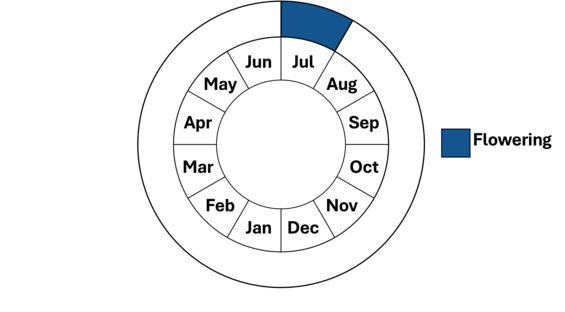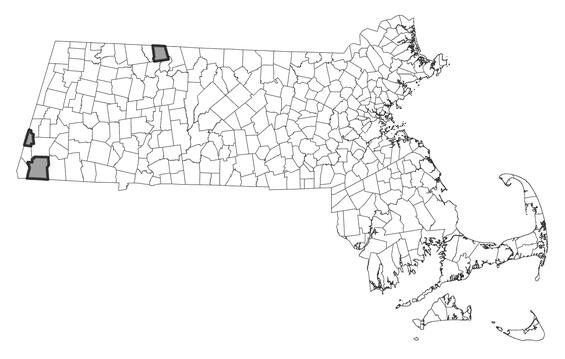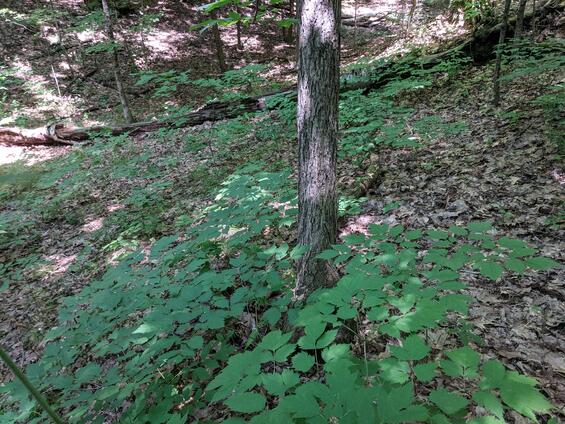- Scientific name: Actaea racemosa L.
- Synonymy: Cimicifuga racemosa (L.) Nutt.
- Species of Greatest Conservation Need (MA State Wildlife Action Plan)
- Endangered (MA Endangered Species Act)
Description

Black cohosh (Actaea racemosa). Photo credit: Robert Wernerehl
Black cohosh (Actaea racemosa, formerly Cimicifuga racemosa) is a striking herbaceous perennial plant of the buttercup family (Ranunculaceae), with alternate, compound leaves and four to nine malodorous, wand-like, white inflorescences. Though indigenous to rich woodlands, black cohosh is also a common garden and herbal medicinal plant, and goes by the other common names black snakeroot, squawroot, and bugbane.
The leaves of black cohosh are 15-60 cm (~6-23 in) in length, smooth, and two to three times “ternately” (i.e., divided in three) compound, with 20-70 toothed leaflets. The flowering stem can be quite tall, reaching up to 2.5 m (~8 ft) in height; it is branched, with several racemes of fetid, white flowers. Individual flowers appear as a mass of stamens with white filaments 5-10 mm long (0.2-0.4 in), topped by rounded anthers. The fruit is a thick-walled follicle, 5-10 mm (0.2-0.4 in) in size.
The leaves of black cohosh resemble those of red baneberry (Actaea rubra) and white baneberry (Actaea pachypoda). Like black cohosh, baneberries are known from rich woodlands and have compound leaves with toothed leaflets, but they are typically much smaller plants. The most distinguishing characters are the inflorescence and the fruit; in baneberries, the inflorescence is an unbranched raceme, and the fruit are berries, not follicles.

Population status
Black cohosh is listed under the Massachusetts Endangered Species Act as Endangered. All listed species are protected from killing, collecting, possessing, or sale and from activities that would destroy habitat and thus directly or indirectly cause mortality or disrupt critical behaviors. It is currently known from Berkshire and Franklin Counties, and is historically known from Hampden, Hampshire, and Worcester Counties. The Massachusetts Natural Heritage & Endangered Species Program database has 7 records from 4 counties: Berkshire, Franklin, Hampshire, and Hampden. Only 4 of these records have been observed within the last 25 years.
Distribution and abundance
Black cohosh is indigenous to eastern North America from Massachusetts and New York, south to Mississippi, Alabama, and Georgia, and west to Ontario, Michigan, Iowa, Missouri and Arkansas.
Only historic occurrences are known from Michigan and Iowa. It has been introduced in Maine.

Distribution in Massachusetts
1999-2024
Based on records in the Natural Heritage Database
Habitat
In Massachusetts, black cohosh inhabits very rich deciduous forests typically with moist alkaline soils. Associated canopy species include sugar maple (Acer saccharum), red maple (A. rubrum), red oak (Quercus rubra), eastern hemlock (Tsuga canadensis), and white ash (Fraxinus americana). Subcanopy and understory woody plants include hazelnut (Corylus americana), ironwood (Carpinus caroliniana), maple-leaved viburnum (Viburnum acerifolium), witch-hazel (Hamamelis virginiana), and spicebush (Lindera benzoin). Associated herbs include lady fern (Athyrium filix-femina), sensitive fern (Onoclea sensibilis), christmas fern (Polystichum acrostichoides), wood ferns (Dryopteris spp.), wild geranium (Geranium maculatum), and blue cohosh (Caulophyllum thalictroides).
Healthy habitats are vital for supporting native wildlife and plants. Explore habitats and learn about conservation and restoration in Massachusetts.

Photo credit: Robert Wernerehl
Threats
Potential threats include competition from invasive species and physical damage from logging, motorized vehicles, and deer browse. A primary threat to this species is competition from exotic invasive species, such as Japanese barberry (Berberis thunbergii), Asiatic bittersweet (Celastrus orbiculatus), garlic mustard (Alliaria petiolata), and Morrow’s honeysuckle (Lonicera morrowii).
Conservation
Survey and monitoring
Black cohosh populations should be monitored periodically to assess these threats and determine if there are management needs.
Management
Though black cohosh is vigorous in higher light conditions, increases in light and soil disturbance (e.g., due to tree harvest) can also increase the vigor and competitive edge of exotic plants. Plans for tree removal or other projects in or near black cohosh habitat that increase light and disturb soil should include strategies to reduce sources of invasive plant introduction (e.g., contaminated machinery) and their spread. Black cohosh plants in deep shade that are not flowering might benefit from some light canopy pruning. Access to black cohosh habitat with motorized vehicles should be prohibited. All active management of state-listed plant populations (including invasive species removal) is subject to review under the Massachusetts Endangered Species Act and should be planned in close consultation with the MassWildlife’s Natural Heritage and Endangered Species Program.
Contact
| Date published: | April 7, 2025 |
|---|